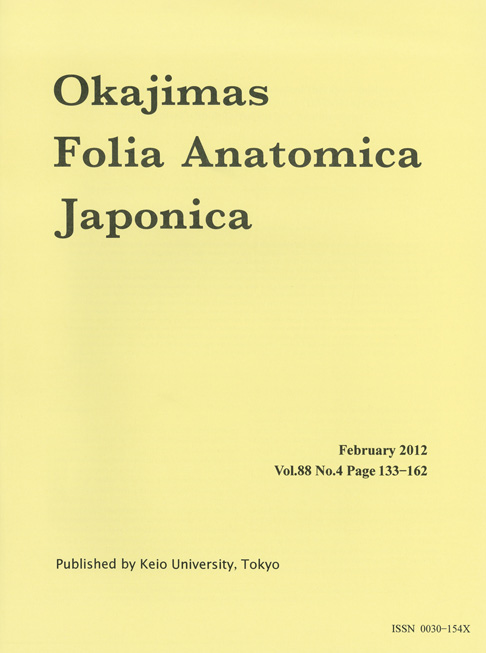All issues

Volume 49 (1972 - 197・・・
- Issue 6 Pages 391-
- Issue 5 Pages 271-
- Issue 4 Pages 175-
- Issue 2-3 Pages 75-
- Issue 1 Pages 1-
Predecessor
Volume 49, Issue 4
Displaying 1-3 of 3 articles from this issue
- |<
- <
- 1
- >
- >|
-
Tokuzo Kojima, Kiichiro Saito, Shigeo Kakimi1972Volume 49Issue 4 Pages 175-225
Published: 1972
Released on J-STAGE: September 24, 2012
JOURNAL FREE ACCESSDownload PDF (10533K) -
Masayoshi Sanefuji1972Volume 49Issue 4 Pages 227-247
Published: 1972
Released on J-STAGE: September 24, 2012
JOURNAL FREE ACCESSA study of the M. masseter was made bilaterally according to the technique of Yoshikawa et al. on a sample of 25 Macaca cyclopis.1) A classification into the M. masseter superficialis (lamina prima and secunda), intermedius (lamina prima and secunda), profundus (lamina prima and secunda) and profundissimus was possible on the basis of the site and condition of origin and insertion, course of muscle bundles, etc. These parts were all supplied by branches from the N. massetericus.
2) The M. masseter superficialis lamina prima in many cases was found to show a formation corresponding to the pars reflexa of Rodentia.
3) In rare cases, conditions presumed to be variations of the M. masseter profundus were found.
4) The muscle located between the M. masseter and M. temporalis, with origin from the inner surface of the arcus zygomaticus and insertion into the lateral surface of the ramus mandibularis, which I called the M. masseter profundissimus is the part corresponding to the so-called M. zygomaticomandibularis of Toldt or the M. maxillomandibularis in the classification of Yoshikawa et al. The portion regarded as the M. zygomaticomandibularis by Yoshikawa et al. is an entirely different muscle from the M. zygomaticomandibularis of Toldt even though the nomenclature is the same and is a part of the M. temporalis.
The nerve supply also indicated that these parts belong to the M. masseter, and there was no apparent need to separate these parts and give them independent names as being part of the improper masseter group.View full abstractDownload PDF (3182K) -
Shozo Matano, Yoshio Shigenaga, Toru Hiura, Akira Sakai1972Volume 49Issue 4 Pages 249-269
Published: 1972
Released on J-STAGE: September 24, 2012
JOURNAL FREE ACCESSI. Cortical fibers from somatic sensory face area (S I-f) were studied with silver staining technic. S I-f in rat cerebral cortex was confirmed by the record of evoked potentials following the mandibular incisor pulp stimulation.
II. The cortico-thalamic fibers from S I-f ipsilaterally terminated in VPM. Preterminal degenerations could be hardly observed in VA, PF-CM complex and PO from S I cortex.
III. The degenerating terminals of the cortical fibers from S I-f were shown contralaterally in the superior and spinal trigeminal nuclei, except for the rostral half of the superior nucleus and the part caudal to level of the pyramidal decussation in the caudal spinal nucleus. At the level of the pyramidal decussation, some degenerated fibers were found to terminate in the formatio reticularis adjoining to this nucleus.
IV. Termination to the nucleus of tractus solitarius was also recognized in its oral part. Almost no degenerating fibers proceeding into the cuneate nucleus were found.
V. The cortical projections from S II are recognized in the thalamic reticular nucleus, VA, VPM, VPL and the medial geniculate nucleus. In PO, only a few degenerating terminals were recognized. On the other hand, degenerated fibers emerging from M I-f showed the presynaptic terminals in the reticular thalamic nucleus, the lateral part of the anterior ventral thalamic nucleus and the subthalamic region. And also, in the pontine and bulbar reticular formation, the degenerating terminals from M I-f were also recognized in the part adjacent to the sensory trigeminal nucleus, while terminations could not be observed in the trigeminal motor, facial and the hypoglossal nuclei.
VI. Some discussions on the terminal distribution of the degenerating fibers were made to compare with results of other animal species.View full abstractDownload PDF (5257K)
- |<
- <
- 1
- >
- >|